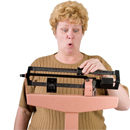 Reaching the age of 50 is often coupled with changes in specific features of our body. On one side are the increases in body weight, body mass index, body fat, blood pressure, and blood glucose levels. On the other side are the reductions in metabolic rates, capacity for digestion, and absorption of nutrients. It is thus important to understand how our body works, especially as we go through the aging process.
Reaching the age of 50 is often coupled with changes in specific features of our body. On one side are the increases in body weight, body mass index, body fat, blood pressure, and blood glucose levels. On the other side are the reductions in metabolic rates, capacity for digestion, and absorption of nutrients. It is thus important to understand how our body works, especially as we go through the aging process.
One of the most common issues related to aging is the increase in total body weight. Around 20 to 30 years earlier, we possessed that slim, firm, and shapely body and thus it is natural for us to try certain quick weight loss measures to get those glorious days back. If hopping on a weighing scale shows that we are overweight or obese, we would think that adapting a quick weight loss regimen that was advertised on TV would do the trick. There are also pills that can suppress your appetite and thus would promise quick weight loss. Or maybe join the local gym and start lifting weights or working out? These quick weight loss approaches can be effective, yet for an individual over 50 years old, these may not be safe anymore.
Age can be a major factor in deciding the most effective and safest approach in losing weight. After age 50, our bodies respond differently to physical activities, unlike the younger people who can participate in running marathons, working out, lifting weights, and depriving themselves of food in order to achieve that goal of quick weight loss. On the other hand, older adults need to consider that the cardiovascular and musculoskeletal systems will be affected by activities such as lifting weights and working out and thus quick weight loss schemes may not be as effective and safe for you. You may also have noticed that lifting weights seems to be more difficult now as an older adult, as compared to doing the same activity during your 20’s. In addition, quick weight loss schemes are not that friendly to an older body, often resulting in dizzy spells and shakes. If these quick weight loss schemes used to work for you 10 or 20 years ago, it may not be that effective at a later point in life due to changes in the body.
In a recent report published in the American Journal of Epidemiology, an evaluation of stroke patients showed that approximately 5% of the study population was engaged in a strong physical activity of lifting weights within one hour of onset of the stroke. Further examination of the study participants showed that they were lifting weights of at least 50 lbs at that time. Interestingly, the study also showed that study participants who were regularly lifting weights, such as the 5- or 10-lb weights when working out, reduced the risk of suffering from a stroke, as compared to individuals who were not regularly working out and lifting weights and thus more or less led a sedentary lifestyle. None of the study participants admitted that they were involved in any quick weight loss program prior to their stroke.
On the basis of this recent report and other previous medical studies, the intensity of activities when working out should always be considered among older adults. Physical activities can be classified as low, intermediate, or high intensity, depending on the particular exercise or the load when lifting weights. Nevertheless, low-intensity levels of working out and lifting weights are still considered as the most effective regimen for weight reduction or maintenance among individuals over 50 years of age. However, additional measures are recommended prior to working out and lifting weights, including stretching and prolonged rest intervals between exercises. It is also important to educate older adults on the diet that is appropriate for their age, which will also support the activities of lifting weights and working out. Although the low-intensity exercises of lifting weights and working out do not immediately result in quick weight loss, these schemes ensure that older adults do not suffer from major cardiovascular disorders as they participate in these activities.
Advertisement
